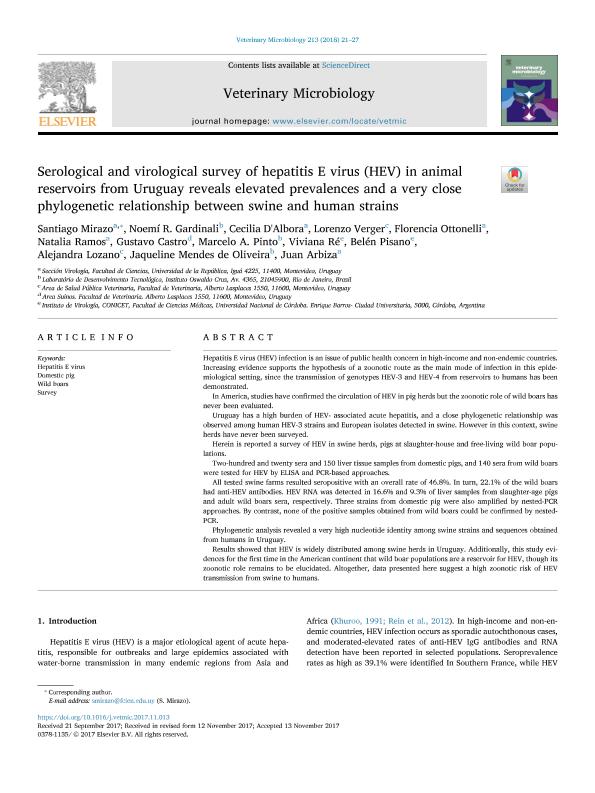Artículo
Serological and virological survey of hepatitis E virus (HEV) in animal reservoirs from Uruguay reveals elevated prevalences and a very close phylogenetic relationship between swine and human strains
Mirazo Villar, Santiago; Gardinali, Noemí R.; Cecilia, D'Albora; Verger, Lorenzo; Ottonelli, Florencia; Ramos, Natalia; Castro, Gustavo; Pinto, Marcelo A.; Ré, Viviana Elizabeth ; Pisano, María Belén
; Pisano, María Belén ; Lozano, Alejandra; de Oliveira, Jaqueline Mendes; Arbiza, Juan
; Lozano, Alejandra; de Oliveira, Jaqueline Mendes; Arbiza, Juan
 ; Pisano, María Belén
; Pisano, María Belén ; Lozano, Alejandra; de Oliveira, Jaqueline Mendes; Arbiza, Juan
; Lozano, Alejandra; de Oliveira, Jaqueline Mendes; Arbiza, Juan
Fecha de publicación:
01/2018
Editorial:
Elsevier Science
Revista:
Veterinary Microbiology
ISSN:
0378-1135
Idioma:
Inglés
Tipo de recurso:
Artículo publicado
Clasificación temática:
Resumen
Hepatitis E virus (HEV) infection is an issue of public health concern in high-income and non-endemic countries. Increasing evidence supports the hypothesis of a zoonotic route as the main mode of infection in this epidemiological setting, since the transmission of genotypes HEV-3 and HEV-4 from reservoirs to humans has been demonstrated. In America, studies have confirmed the circulation of HEV in pig herds but the zoonotic role of wild boars has never been evaluated. Uruguay has a high burden of HEV- associated acute hepatitis, and a close phylogenetic relationship was observed among human HEV-3 strains and European isolates detected in swine. However in this context, swine herds have never been surveyed. Herein is reported a survey of HEV in swine herds, pigs at slaughter-house and free-living wild boar populations. Two-hundred and twenty sera and 150 liver tissue samples from domestic pigs, and 140 sera from wild boars were tested for HEV by ELISA and PCR-based approaches. All tested swine farms resulted seropositive with an overall rate of 46.8%. In turn, 22.1% of the wild boars had anti-HEV antibodies. HEV RNA was detected in 16.6% and 9.3% of liver samples from slaughter-age pigs and adult wild boars sera, respectively. Three strains from domestic pig were also amplified by nested-PCR approaches. By contrast, none of the positive samples obtained from wild boars could be confirmed by nested-PCR. Phylogenetic analysis revealed a very high nucleotide identity among swine strains and sequences obtained from humans in Uruguay. Results showed that HEV is widely distributed among swine herds in Uruguay. Additionally, this study evidences for the first time in the American continent that wild boar populations are a reservoir for HEV, though its zoonotic role remains to be elucidated. Altogether, data presented here suggest a high zoonotic risk of HEV transmission from swine to humans.
Palabras clave:
DOMESTIC PIG
,
HEPATITIS E VIRUS
,
SURVEY
,
WILD BOARS
Archivos asociados
Licencia
Identificadores
Colecciones
Articulos(CCT - CORDOBA)
Articulos de CTRO.CIENTIFICO TECNOL.CONICET - CORDOBA
Articulos de CTRO.CIENTIFICO TECNOL.CONICET - CORDOBA
Citación
Mirazo Villar, Santiago; Gardinali, Noemí R.; Cecilia, D'Albora; Verger, Lorenzo; Ottonelli, Florencia; et al.; Serological and virological survey of hepatitis E virus (HEV) in animal reservoirs from Uruguay reveals elevated prevalences and a very close phylogenetic relationship between swine and human strains; Elsevier Science; Veterinary Microbiology; 213; 1-2018; 21-27
Compartir
Altmétricas



